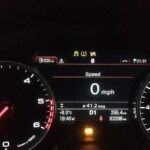Understanding your Volkswagen Vehicle Identification Number (VIN) can unlock a wealth of information about your car. This comprehensive guide will break down the meaning of each character in your Vw Vin Code, enabling you to decipher its secrets.
A VW VIN code is a 17-digit alphanumeric sequence that uniquely identifies every Volkswagen manufactured since August 1, 1979. This standardized code, adopted globally by automakers, provides valuable details about your vehicle’s origin, specifications, and manufacturing details. Let’s dissect each section of the VW VIN code:
Section 1: World Manufacturer Identifier (WMI) – Digits 1-3
The first three digits of your VW VIN code represent the World Manufacturer Identifier (WMI).
- Digit 1: Indicates the geographic region of manufacture (e.g., S-Z for Europe). For Volkswagen, this is typically “W”.
- Digit 2: Specifies the manufacturer within that region. “V” usually signifies Volkswagen, but variations exist.
- Digit 3: Broadly categorizes the vehicle type (e.g., passenger car, truck). Combined with the first two digits, this completes the unique WMI for Volkswagen.
Common Volkswagen WMIs include:
- WVW: Volkswagen Cars
- WVG: Volkswagen SUVs
- WV1: Volkswagen Commercials
- 1VW: Volkswagen USA (cars)
- WAU: Audi
Section 2: Vehicle Descriptor Section (VDS) – Digits 4-9
Digits 4-9 of the VW VIN code comprise the Vehicle Descriptor Section (VDS), revealing specific vehicle attributes.
-
Digits 4-6: Often “ZZZ” for European and Australian models, these digits signify details like body style, engine, and trim for US models.
-
Digits 7-8: Crucially identify the Volkswagen model and platform. For instance:
- 17: Golf 1
- 1G: Golf and Jetta 2 (late)
- 3C: Passat 6, 7, 8, CC
- 7L: Touareg 1
- AW: Polo 6
-
Digit 9: Typically “Z” as a filler digit for most markets outside the US. American VWs utilize this as a check digit for VIN accuracy.
Section 3: Vehicle Identifier Section (VIS) – Digits 10-17
The final eight digits (10-17) form the Vehicle Identifier Section (VIS), pinpointing the individual vehicle.
-
Digit 10: Represents the model year, using a specific code (A=1980, B=1981, and so on, skipping I, O, Q, U, Z, and 0). This code repeats every 30 years. For example, “L” represents both 1990 and 2020.
-
Digit 11: Indicates the factory where the vehicle was assembled. Each Volkswagen plant has a unique code (e.g., W for Wolfsburg, Germany).
-
Digits 12-17: This is the unique serial number of your specific Volkswagen, starting at 000001 and incrementing for each vehicle produced at that factory.
Utilizing Your VW VIN Code
By understanding your VW VIN code, you can gain valuable insights into your car’s history and specifications. This knowledge is useful for:
- Verifying vehicle history reports.
- Confirming compatibility of parts.
- Researching recalls and service bulletins.
- Determining the authenticity of your Volkswagen.
Decoding your VW VIN code empowers you with essential information about your vehicle. By utilizing this guide, you can unlock the hidden story behind those 17 characters.

